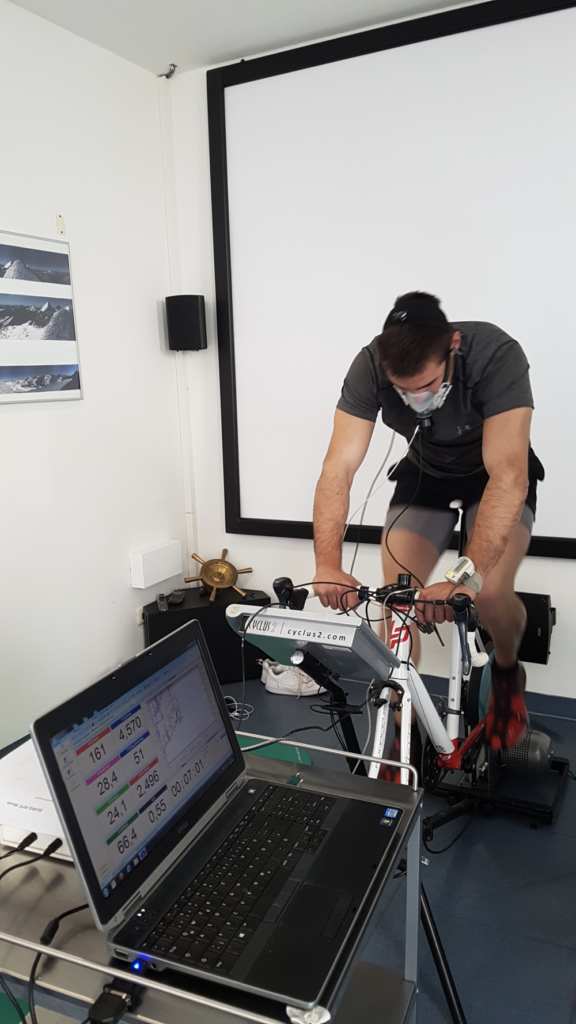It is getting closer and closer. In about 4 weeks from now Jur will start his biggest adventure in life. We are working very hard on the final preparations. Logistics is very challenging but it looks like everything is falling into place. So exciting! Because it is only 1 month before departure it is now time to start to taper-off in the training schedule. This means we build down the impact and volume of the training load to give the body a better change for recovery. (Find the full training program here).
Besides tapering-off and the mental count down, we are also experimenting with possible means to achieve some acclimatization in advance. There is increasing interest in methods by which people can achieve some degree of acclimatization before going in to the mountains, but there is still no hard evidence that it is possible to achieve a state of acclimatization (at sea level) in the body that is beneficial in the mountains. But we don’t want to leave it out. If we don’t gain from it we will certainly not lose anything from it.
Pre-acclimatization serves the purpose of preventing the manifestation of AMS. Symptoms of AMS are among others headache, dizziness, nausea, loss of appetite and fatigue/weakness. Depending on the degree of AMS, cognitive and motoric performance are severely disturbed. Most commercially guided tours to greater altitudes offer continuous acclimatization on the mountain, in order to reduce the risk of AMS.

Hypoxic training
Hypoxic training is the idea of training in low oxygen environments, so that your body will learn to create the same amount of energy with a significantly lower amount of oxygen. It trains your body to function more effectively in an oxygen debt. It also causes your body to produce more oxygen carrying red blood cells as an adaptive response. You can do this by purchasing hypoxic training equipment, such as a mask. The potential downsides to hypoxic training are that power outputs are diminished, muscle mass may be lost, over training happens more often due to slower recovery times, and performance plateaus tend to become common (which can have a negative effect on confidence) because there is only so far you can push your body with less oxygen.

Sleeping at 3500 m of altitude in your own basement
By spending 2-3 nights per week in a tent which is connected to a machine that simulates the composition of the air at high altitude, we hope to achieve an increase in red blood cells. These machines can be programmed to give any pattern of bursts of hypoxia (low oxygen dense air) or normoxia (air with normal oxygen levels). Last week we determined a starting altitude of 2600m and are gradually building it up until the day of departure.
Besides the hope for these physical results in the blood we also want Jur to get used to the difficulty of sleeping in low oxygen dense air. By spending these nights in the simulated situation we hope he trains the body to become better at it in the real time altitude situation. Sleep might be even more important for the project’s outcome than nutrition is.
At this moment we can state that the first night was a quite uncomfortable one but following nights clearly went better.

We already mentioned it before, GO SLOW!
It will take time and patience to acclimatize in a safe and optimal way. Time is not in abundance next year and therefor we want to give this simulated training a chance. To safe some time it would be awesome if we can create some acclimatization up front.
Building it up slowly is also the main rule when implementing hypoxic sleeping and training at home.
The picture on the right show’s Jur after his first night at simulated altitude (2600m). Does it effect the body, or is this just Jur’s morning color ;)?
The first high altitude attempt will give us more clarification on the benefits of this pre-acclimatization trajectory we did.
Commute fast and climb up high to rest
First mountain to climb is going to be Mount Vinson. A 4.892 m high mountain. When completing this cold and remote friend we prefer to go to Mount Aconcagua, number two on the list, as fast as possible to benefit the most out of Mount Vinson’s acclimatization. This means commute fast and try to get up high within a preferred 6-8 days. Ideal would be to climb up to an altitude of a least 3000m. This is why we are working on a tight travel plan and looking for a comfortable hang out on Mount Aconcagua’s route up the summit.
Measurements on acclimatization
We discussed this topic briefly before. There are a few ways to measure the level of acclimatization in the body. First of all a very good result would be if sleeping in the tent while building it up becomes easier and easier. However, we don’t exactly know what the physical outcome is, we will be very much helped with the trust it brings that sleeping at high altitude is perfectly doable.
A blood test just a few days before catching the flight to Punta Arenas can show us the results of the possible changes in red blood cell levels. But the best measurement is going to be at high altitude on Mount Vinson.
Do it yourself!
To pre-acclimatize at sea level you will need the simulation machine. These machines and tents can be rented as they are quite expensive. If you have the chance my advice would be to go into the mountains to seek for the altitude stimulus as this is the “real” oxygen dense air and because it will provide you with the best training terrain you can get.
If you like to have more information on hypoxic training, feel free to ask your questions in the comments below or send me an email with your situation to; [email protected]


